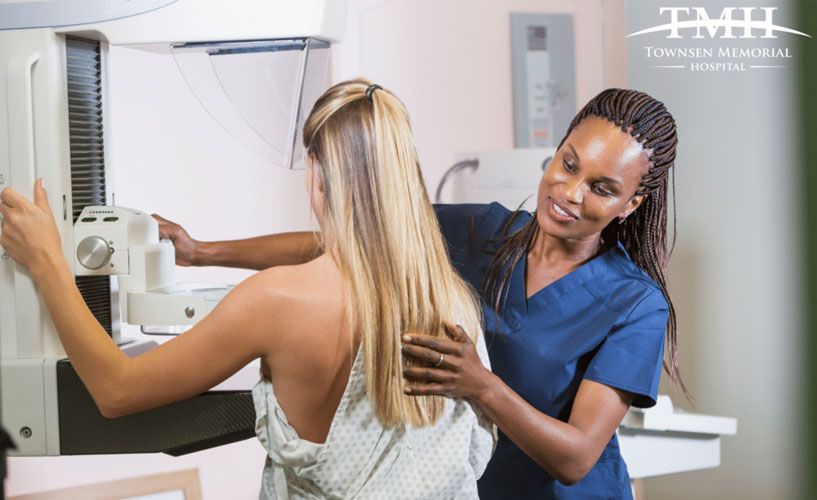Early Cancer Detection Using Mammograms And Breast Ultrasound

Early detection can help save lives, particularly when it comes to breast cancer. During a breast cancer screening, your doctor checks your breasts for signs of cancer, such as lumps or changes in the tissue. The most common imaging tests done to check for breast cancer are mammograms and ultrasound of the breast. Women should get annual screenings to ensure nothing has changed or developed that may be a cancer risk. If your doctor finds something unusual that will require another look, e.g., a hard lump, they may send you to get medical imaging done to check whether it is cancerous or benign.
Mammography
A mammogram is a picture of the breasts taken using x-ray imaging. It is one of the most commonly used screening tools to detect breast cancer. In some cases, mammograms allow doctors to detect breast cancer up to three years before a tumor is palpable. A woman with an average risk of breast cancer can benefit from getting mammograms starting at age 40. However, a woman with a higher risk, i.e., has a family history of breast cancer, may want to start screening earlier. It is very important to know your family history so that you can take the best course of action. For instance, if your mother had breast cancer at age 45, your doctor may ask that you start your mammogram screenings ten years prior to her age of diagnosis, which is at 35.
During a mammogram, your breast rests on a plate while a second plate gets lowered on top of the breast pushing it flat to hold it still while the x-ray machine takes the image. The radiology technician performing the test will capture images from the front and the side, taking four pictures total, two of each breast. Depending on your level of sensitivity, while the procedure may be a little uncomfortable, it should not be painful and should be done pretty quickly.
A disadvantage of a mammogram is that some women can have dense breast tissue, which makes it hard to find tumors because they both appear white on the images. In that case, an ultrasound is usually ordered alongside the mammogram.
There are many factors that affect whether mammography is able to detect breast cancer:
- The age and weight of the patient.
- The size and type of tumor.
- Where the tumor has formed in the breast.
- How sensitive the breast tissue is to hormones.
- How dense the breast tissue is.
- The timing of the mammography within the woman’s menstrual cycle.
- The quality of the mammogram picture.
- The skill of the radiologist in reading the mammogram.
Breast Ultrasound
A breast ultrasound, or sonogram, uses sound waves to create a picture of the inside of the body. It does not use radiation so it is generally safe for those who need to avoid x-rays, such as pregnant women. A breast ultrasound can be helpful to your radiologist if they had trouble seeing your mammogram images due to dense breast tissue.
During an ultrasound, your technician will hold a wand, known as a transducer, over the breasts throughout the imaging test. The transducer sends sound waves that bounce off the breast tissue, traveling back to the transducer and creating an image.
Is One Better Than The Other?
Your doctor is very likely to order both tests as there are several notable differences between the two:
- The imaging modality
- The quality of the images produced
- The reasons for the imaging
A breast ultrasound alone is not currently a recommended screening tool for breast cancer, because it can miss many early signs of a tumor. However, some patients might be better candidates for an ultrasound as opposed to a mammogram. Pregnant women, for instance, should usually avoid having x-rays performed unless the imaging is essential. A breast ultrasound might also be a better option for younger women, particularly those in their 20s.
Whether an ultrasound or mammogram is the right option for you depends on your needs and your doctor’s recommendations.
Townsen Memorial Hospital’s Imaging Center in Humble is now open! From Ultrasounds to Mammograms, we offer a wide variety of services operated by skilled medical professionals to provide patients with the best in imaging and patient care. We not only have technological advancements, but we also have a medical team that is always going to put you first.
Townsen Memorial Hospital Is Here For You
At Townsen Memorial, safe, effective, and affordable care is our top priority. Therefore, we strive to provide the best patient experience across all Townsen Memorial affiliated sites. The high-quality care starts at our Emergency Room and carries on through our Imaging Centers, Surgery Centers, and up through our Townsen Memorial Hospital. Our medical sites are located in Houston, TX, and the surrounding areas, to provide the best care to patients in and around Harris County. To learn more, visit our website or call 1-877-494-9487.
Clinics, Health Tips, Imaging Centers, Breast cancer, MRI, CT Scan, womens health, cancer, ultrasound
